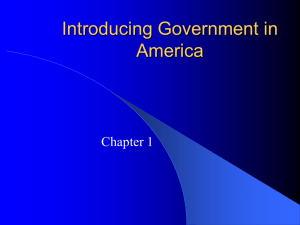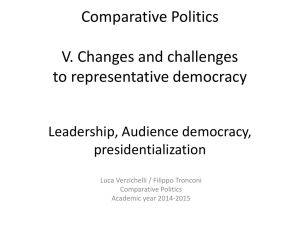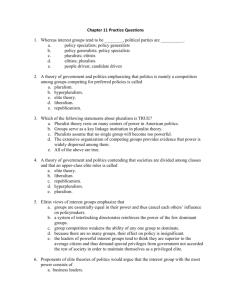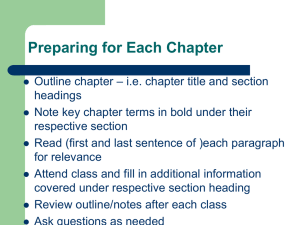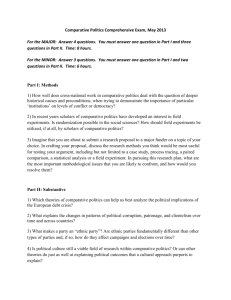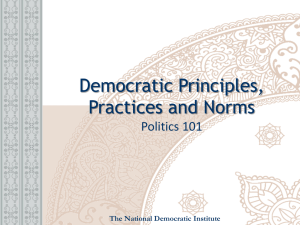Chapter 1: Introducing Government in America
advertisement
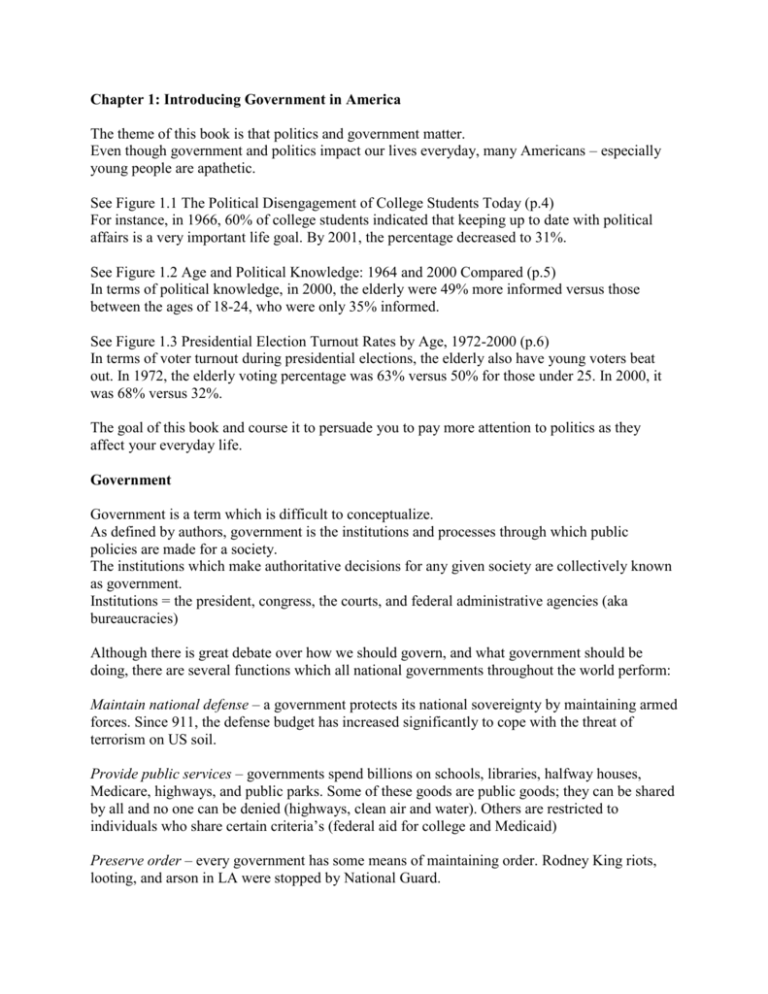
Chapter 1: Introducing Government in America The theme of this book is that politics and government matter. Even though government and politics impact our lives everyday, many Americans – especially young people are apathetic. See Figure 1.1 The Political Disengagement of College Students Today (p.4) For instance, in 1966, 60% of college students indicated that keeping up to date with political affairs is a very important life goal. By 2001, the percentage decreased to 31%. See Figure 1.2 Age and Political Knowledge: 1964 and 2000 Compared (p.5) In terms of political knowledge, in 2000, the elderly were 49% more informed versus those between the ages of 18-24, who were only 35% informed. See Figure 1.3 Presidential Election Turnout Rates by Age, 1972-2000 (p.6) In terms of voter turnout during presidential elections, the elderly also have young voters beat out. In 1972, the elderly voting percentage was 63% versus 50% for those under 25. In 2000, it was 68% versus 32%. The goal of this book and course it to persuade you to pay more attention to politics as they affect your everyday life. Government Government is a term which is difficult to conceptualize. As defined by authors, government is the institutions and processes through which public policies are made for a society. The institutions which make authoritative decisions for any given society are collectively known as government. Institutions = the president, congress, the courts, and federal administrative agencies (aka bureaucracies) Although there is great debate over how we should govern, and what government should be doing, there are several functions which all national governments throughout the world perform: Maintain national defense – a government protects its national sovereignty by maintaining armed forces. Since 911, the defense budget has increased significantly to cope with the threat of terrorism on US soil. Provide public services – governments spend billions on schools, libraries, halfway houses, Medicare, highways, and public parks. Some of these goods are public goods; they can be shared by all and no one can be denied (highways, clean air and water). Others are restricted to individuals who share certain criteria’s (federal aid for college and Medicaid) Preserve order – every government has some means of maintaining order. Rodney King riots, looting, and arson in LA were stopped by National Guard. Socialize the young – modern governments pay for education and use it to instill national values among the young – Civil Values Simulation Collect taxes – money which is used to pay for public goods and services provided by the government. To understand how we should govern, and what government should be doing, we must turn to politics. Politics Textbook = politics = the process by which we select our governmental leaders and what policies these leaders pursue. Politics produce authoritative decisions about policy issues. Harold Lasswell = politics = who gets what, when and how. The media usually focuses on the who of politics; this could be voters, candidates, groups, and parties. What refers to the substance of politics and government – benefits such as medical care for the elderly, or burdens such as new taxes. How people participate in politics is important too; they get what they want through voting, supporting, compromising, lobbying, and so forth. In this sense, government and politics involves winners and losers. Political participation involves the way people get involved in politics; voting, protests, civil disobedience. All activities used by citizens to influence the selection of political leaders of the policies they pursue. The Policymaking System The policymaking system reveals the way our government responds to the priorities of its people; it is a process by which policy comes into being and evolves over time. See Figure 1.4 The Policymaking System (p. 12) People = interests, problems, concerns Examples: gay marriage, separation of church and state, abortion, equal employment opportunity Linkage institutions = parties, elections, media, interest groups Turns people’s concerns into political issues that appear on the policy agenda; Political issues arise when people disagree about a problem and how to fix it. Policy agenda = political issues The issues that attract serious attention from public officials and those involved in politics Policymaking institutions = legislature, executive, courts, bureaucracy Branches of government charged with taking action on political issues. Policy = expenditures, taxes, laws, regulations, non-decisions A choice that government makes in response to a political issue/problem People = impacts of policies Translating people’s desires into effective public policy is crucial to the workings of democracy. Democracy Defining Democracy Democracy is yet another concept that is difficult to conceptualize. Democracy is a means of selecting policymakers and of organizing government so that policy reflects citizens’ preferences. Today the term is synonymous with freedom, justice, and peace – positive connotations. However, not all view or define democracy as we do in America. Traditional Democratic Theory Traditional democratic theory rests upon a number of key principles that specify how governmental decisions are made in a democracy. According to Robert Dahl, an ideal democratic process should satisfy five criteria’s: Equality in voting = 1 person 1 vote Effective participation = citizens must have adequate and equal opportunities to express their preferences throughout the decision making process Enlightened understanding = a democratic society must be a marketplace of ideas; free press, free speech; citizens must be able to understand issues Citizen control of the agenda = citizens should have a collective right to control the agenda Inclusion = the government must include and extend rights to all those subject to its law; citizenship must be open to all. Democracies must also practice majority rule = in choosing alternatives, the will of over half the voters should be followed. At the same time, restraints on the majority must also be placed because we don’t want the majority to have free reign over everything they want. Minority rights = guarantees rights to those who do not belong to the majority; basic principles such as freedom of speech and of assembly are essential minority rights. Note = minority rights does not necessary mean race and ethnicity. Democracies must also involve representation = the relationship between the few leaders and the many followers. In politics, this means that the desires of the people should be replicated in government through the choices of elected officials. How do traditional democratic theories play out in American democracy? Theories of American Democracy disagree over the extent to which democracy plays out in America. Contemporary Theories of American Democracy Pluralist Theory: states that groups with shared interests influence public policy by pressing their concerns through organized efforts. Groups such as the NRA (national riffle association) NOW (national organization for women), and UAW (united auto workers) are examples of groups of people who share common interests. Because of the open access to various institutions of government and pubic officials, organized groups can compete with one another for control over policy, and yet no one group or set of groups dominates. Given that power is dispersed, groups that fail in one arena, can move on to the next. Rather than speak of majority rule, pluralism speaks to groups of minorities working together. Critique = Robert Putnam, Bowling Alone, the problems of democracy today stems from a decline in group participation. Elite and Class Theory: critics of pluralism believe that it paints too rosy of a picture of American life. By arguing that almost every group can get a piece of the pie, pluralists have missed the big picture – how the pie is distributed. The poor may get food stamps, but the wealthy get huge tax deductions worth far more. Some government programs may help minorities, but the income gap between African Americans and Whites remains the same. Elite and class theory argue that society is divided along class lines and that an upper class elite pulls the strings in government. Wealth – the holding of assets such as property, stocks and bonds – is the basis of this power. They believe that 1% of Americans control most policy decisions because they can afford to finance election campaigns and control key institutions, such as large corporations. A few powerful Americans not only influence policymaking, they are the policymakers. At the center of all theories of elite dominance is big business; the corporate giants always have power. Hyperpluralism: offers a different critique of pluralism. Hyperpluralism is pluralism gone sour. Groups are so strong that government is weakened; the influence of many groups cripples government’s ability to make policy. Whereas pluralism maintains that input from groups is a good thing for political decision making, Hyperpluralism asserts that there are too many ways for groups to control policy. Groups have become sovereign (rulers), and government is the servant. Powerful groups also divide the government and its authority. Like elite and class theory, Hyperpluralism also argues that public interests are rarely translated into public policy. Challenge to Democracy Regardless of which theory is more convincing, there are a number of continuing challenges to democracy: Increased Technical Expertise = we live in a society of experts, whose technical knowledge overshadows that of the general population; elites are more likely to be those who command knowledge, the experts. Limited Participation in Government = citizenship is not taken seriously; people know little of politics; people aren’t voting; and, people are not participating in government. As a result, the foundations of democracy are being challenged. Escalating Campaign Costs = campaign costs are becoming so expensive, that politicians are turning to contributions from PAC (political action committees) to compete. PACs represent specific economic interests, and they only care how congressmen vote on their particular issues. Because congressmen need PAC money for reelection, they listen to their concerns. When democracy confronts the power of money, the gap between theory and practice widens. Diverse Political Interests = the distribution of power among government is so decentralized, that interest groups find it easy to gain access to policymakers. Access to a few policymakers may be enough to determine the outcome of public policy. Policy gridlock occurs when no coalition is strong enough to form a majority and establish policy - abortion. The result is that nothing gets done – they work to veto each others policies.

